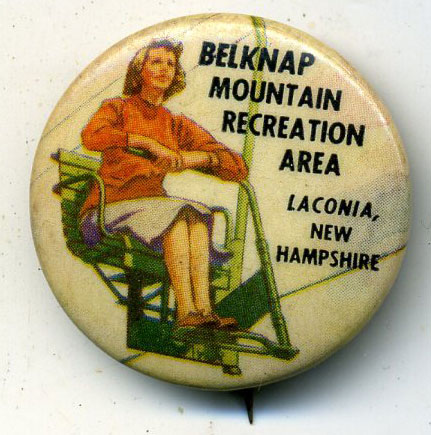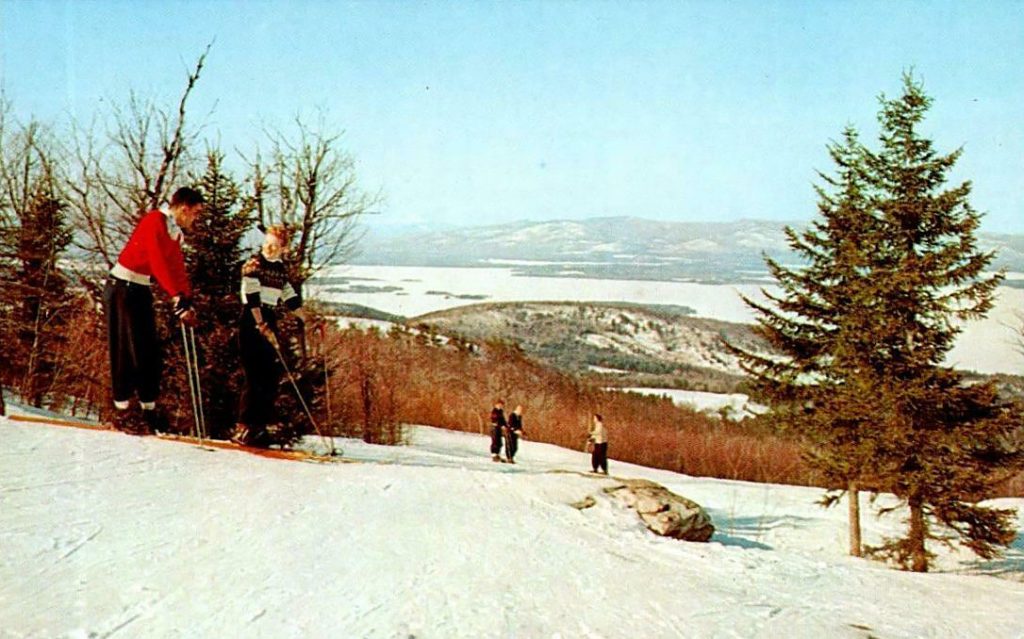I received a call this week from Alan Kovacs who provided more details on the new parking program at Stowe. The deal that was negotiated between Vail Resorts and the Vermont Departments of Natural Resources and Forest and Parks treats the parking program as a test. There will be a review after the season to evaluate the results in as many measurable ways as possible. The state waived the 5% revenue charge in return for Vail’s promise to use all the revenue for traffic alleviation and related infrastructure. The resort has already committed $260,000 to Green Mountain Transit for the purchase of two new large buses.
Alan also explained that the lease deal with the state is more complicated than just a flat 5%. Different types of revenue are charged varying percentages from 2.5% to 5%. Boy, keeping track of all that must be a bookkeeping nightmare!
On to this week’s column! The Lakes region of New Hampshire may not seem like a place with a rich history of skiing, but the Winnipesaukee Ski Club started promoting the region as a skiing destination as early as 1918. Laconia had good rail service from the Boston area and ski trains brought skiers to enjoy both cross country and downhill opportunities on the nearby hills and mountains. Gunstock was one of those mountains.
The 1930s brought Franklin Delano Roosevelt’s New Deal to the region. The local Belknap County government saw an opportunity with the influx of Federal money. They formed the Belknap Mountains Recreation Area which would eventually develop year-round recreation opportunities including their “famous” motorcycle races! For the winter seasons they took advantage of ski jumping’s popularity and built three ski jumps of varying sizes. Then for the 1937-38 season they built the first chairlift in New England on Mt. Rowe which is next to Gunstock mountain.
Just an aside here, this chairlift was involved in a tragic accident in 1956. The cable snapped and one person was killed and several injured. When I was a freshman in college, this provided a sample problem to solve in the Introduction to Engineering course! To reduce cable wear, every year they would remove all the chairs, move the last one a distance along the cable, and then space the remaining chairs at the specified distance. What did they do wrong? I’ll accept answers to that as well as my trivia!
Belknap Mountain Recreation Area, or Belknap as I grew up calling it, would become Gunstock when additional lifts were added to the adjacent mountain in 1962. Eventually the lift on Mt. Rowe was removed and the trails allowed to return to nature. Gunstock is the only county-owned ski area in New England!
And that’s why Gunstock was in the news this past summer! There are three governing county entities involved – the Belknap County delegation, Gunstock Area Commission, and Belknap County Commission. The “delegation” consists of the county’s 18 elected representatives to the state legislature. They in turn appoint the 5 members of the Gunstock Area Commission who oversee the ski area. The 3 members of the Belknap County Commission are elected officials and they oversee the spending among all the county departments. Anytime elected officials are involved these days you know there will be political complications!
Back in 2000, one of the Gunstock Area Commission members was a name familiar to Stowe-ites, Gary Kiedaisch! His influence led to the hiring of Tom Day as General Manager for the ski area. Under Day’s leadership Gunstock set a record for skier visits in the 2020-21 season and revenue increased from $12 million to $18 million. This past season continued that growth.
On July 20, 2022 Tom Day and his whole management team resigned and Gary Kiedaisch resigned from the Commission. So what happened? The short answer is the Free Staters! The Free State Project has targeted New Hampshire as a sympathetic place to apply their limited or no government philosophy and urged their members to move there (20,000 signed up.) They have infiltrated enough elected or appointed positions to have an effect on school budgets, state-run nursing homes, and ski areas! Two of the recently appointed Gunstock Area Commissioners insisted on limiting the control of the Gunstock management team.
There are grass roots efforts to try to overcome the Free State influence and in the case of Gunstock, it worked! The Commissioners whose objections led to the mass resignations were forced to resign themselves! Tom Day and his management team were restored and Gunstock is looking forward to the upcoming ski season!



December 14, 2022 at 11:02 pm
In 1945 my father moved his family to Gilford, NH, desiring to return to his boyhood home of of Meredith and Laconia in the Lakes Region, he bought a small house on Rt 11A about a mile and one half from Gunstock. From that time on to 1965 after college graduation I was one of many very fortunate local residents to benefit from its Belknap County ownership.
As Greg explained it had been given a typical US Government issued moniker of “Belknap Mountain Recreation Area” having been built by the Works Progress Administration. It was known locally simply as “the area” and by New England skiers just as “Belknap.” In my high school years in the late ’50s tickets were $1.00 a day!
The ski area never did occupy Belknap Mountain, the slightly higher peak just to the south of Gunstock, hence the name was changed I believe sometime in the ’70s to the more aptly descriptive Gunstock. It was a great place to “hang out” even during the summer with many different Lakes Region events being held there such as ski jumping on crushed ice, the NH League of Craftsmen annual fair, summer scenic chairlift rides and the infamous motorcycle tour which is now truly a humongous event!
From what I have been told and have read, the success of the tropical cable banana lifts in Central America modified into the first chairlift at Sun Valley was the perfect reason to have one purposely designed and built at Belknap which opened in 1937.
I was thirteen when the cable snapped which resulted in NH establishing, as I remember, the first Tramway Safety Regulatory Agency in the US.
Not being an engineer and as a true stab in the dark I will take a guess at the trivia question about the mandated safety inspection of the chairs and haul rope after that event.
I was not really aware of the method you described used for the yearly inspection and moving the chairs; however it must have been at least not until the late ’70s or perhaps even into the ’80s when I first noticed the progressively faded paint marks on the haul rope left when the chairs are moved for inspection of any corrosion or damage at the attach point. I was not living in the East at that time but I believe by then all states were regulating tramways and it was most likely done nationwide if not worldwide?
If that method was not done in early days and from what you described as a mistake made, I would guess it would have been very easy to lose track of where chairs were originally located and if replacement spacing was not exact I can imagine it would be possible to re-attach precisely at one of the points where they had been located before and nullify the whole exercise?
I also do remember specifically (from actually asking the summer lift crew doing the work) what the electric unit was which was being used on either side of the chair grip and being told rather abruptly it was a vulcanizer.
Not wishing to ask any more naive questions of the crew foreman, (he was both summer and winter operations manager) I of course had to go home and ask my father what a vulcanizer was.
Please correct me if I am wrong but I remember from newspaper articles that the cause of the cable parting was that the tapered rubber located on either side of the chair grip securely bound to the cable (the immediate definition of vulcanization which I googled while writing this!) was commonplace in those days and the steel cable not having been inspected for nearly twenty years, the many completely broken strands of cable hidden beneath the rubber was the reason?
Donald Simonds
Stowe